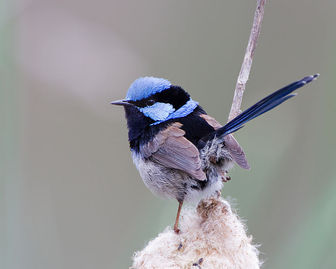Superb Fairywren
Like other fairywrens, the Superb Fairywren is notable for several peculiar behavioural characteristics; the birds are socially monogamous and sexually promiscuous, meaning that although they form pairs between one male and one female, each partner will mate with other individuals and even assist in raising the young from such pairings. Male wrens pluck yellow petals and display them to females as part of a courtship display.

Original source: Own work
Author: Noodle snacks (http://www.noodlesnacks.com/)Camera location
The Superb Fairywren is classified as Least Concern. Does not qualify for a more at risk category. Widespread and abundant taxa are included in this category.
Like other fairywrens, the Superb Fairywren is notable for several peculiar behavioural characteristics; the birds are socially monogamous and sexually promiscuous, meaning that although they form pairs between one male and one female, each partner will mate with other individuals and even assist in raising the young from such pairings. Male wrens pluck yellow petals and display them to females as part of a courtship display. More
Like other fairywrens, the Superb Fairywren is unrelated to the true wren. It was previously classified as a member of the old world flycatcher family Muscicapidae and later as a member of the warbler family Sylviidae before being placed in the newly recognised Maluridae in 1975. More recently, DNA analysis has shown the Maluridae family to be related to the Meliphagidae (honeyeaters), and the Pardalotidae (pardalotes, scrubwrens, thornbills, gerygones and allies) in the large superfamily Meliphagoidea. More
The Superb Fairywren is one of 12 species of the genus Malurus, commonly known as fairywrens, found in Australia and lowland New Guinea. Within the genus, the Superb Fairywren's closest relative is the Splendid Fairywren; these two "Blue wrens" are also related to the Purple-crowned Fairywren of northwestern Australia. More
The Superb Fairywren can be found in almost any area that has at least a little dense undergrowth for shelter, including grasslands with scattered shrubs, moderately thick forest, woodland, heaths, and domestic gardens. It mainly eats insects and supplements its diet with seeds. William Anderson, surgeon and naturalist on Captain James Cook's third voyage, collected the first Superb Fairywren specimen in 1777 while travelling off the coast of eastern Tasmania, in Bruny Island's Adventure Bay. More
yellow thornbills, superb fairywren, common bronzewing and yellow rosella. Having established at least three species of mistletoe in the paddock, we now see mistletoebird regularly. Emus with their fondness for ruby saltbush and Eremophila berries are often there, disseminating seeds about. More
Superb Fairywren, South Australia, St Kilda August 2009 © Rob Morris Superb Fairywren - Superb Fairywren, Australia, Kiama October 04 © Mark Harper Send this as a postcard Superb Fairywren - Superb Fairywren, South Australia, St Kilda August 2009 © Rob Morris Superb Fairywren - Showing Records 1 through 3 of 3 Total Records More

Original source: MGA73bot2
Author: MGA73bot2
Permission: Some rights reserved
Family : Maluridae
Genus : Malurus
Species : cyaneus
Authority : (Latham, 1783)
